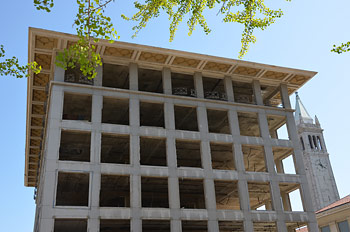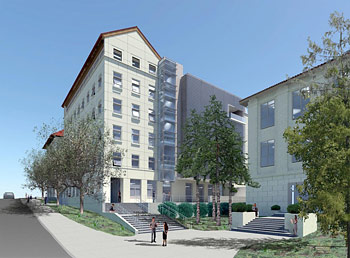Campbell Hall bites the dust, clearing space for LEED-certified replacement
Demolition crews began tearing down the 53-year-old Campbell Hall Thursday to make way for a new, 82,000-square-foot LEED-certified facility for astronomy and physics.
May 10, 2012
Demolition crews began tearing down Campbell Hall Thursday to make way for a new LEED-certified facility — also to be known as Campbell Hall — for UC Berkeley’s astronomy and physics departments.
“The replacement of Campbell has been on the agenda for some time, so it’s exciting to finally have the project underway,” said Christine Shaff, Berkeley’s director of communications for facilities services. “The goal is to create a new, more efficient building that’s better suited to supporting the modern teaching and research needs of the campus.”

Constructed in 1959, Campbell Hall was cramped, outmoded and had been rated as seismically poor.
The 53-year-old building, at Hearst Mining Circle and Oppenheimer Way, will be demolished from the top down using a high-reach excavator, which arrived on campus last week direct from San Francisco’s Doyle Drive teardown project.
Fitted with rotational hydraulic claw-like shears, the giant excavator will dismantle Campbell’s six-story concrete and steel structure floor-by-floor down to ground level, before excavating the building’s single below-ground floor.
“This is a small site with many tightly clustered buildings adjacent,” said Shaff. “Imploding a multi-story building is expensive, loud and really messy, and would have impacted nearby research that is vibration sensitive.”
Crews finished stripping out building interiors and exterior elements of the structure last week, ahead of major demolition work. Many of the existing building’s fixtures and fittings, such as doorknobs and window frames, were salvaged for reuse in other buildings across campus. Workers also removed the red-clay roofing tiles, which will be stored for future use.
Demolition and site-clearing work — more than 90 percent of debris will be recycled — is scheduled to continue over the next four weeks. Crews placed protective panels over the windows of the LeConte Hall to minimize noise impacts and are also using water hoses to mitigate dust dispersal.
Replacing the cramped and outmoded Campbell Hall, which was constructed in 1959 and has a seismic rating of “poor,” will cost an estimated $87 million. Chancellor Robert Birgeneau will attend a groundbreaking ceremony Monday to mark the transition to the construction phase of the project.

The planned 82,000-square-foot replacement building is designed to achieve LEED Silver certification.
At 82,000 square feet, the new building, designed by Studios Architecture to achieve the U.S. Green Building Council’s LEED Silver rating, will be significantly more spacious than Campbell. It will feature a rooftop observatory and six above-ground floors of instructional, research, administrative and support space for astronomy and physics.
The basement level will house a low-noise, low-vibration research laboratory, to be called the Center for Integrated Precision and Quantum Measurement. The state-of-the-art physics research lab is being funded in part with an $11 million federal grant from the National Institute of Standards and Technology.
The replacement of Campbell Hall marks the final phase of a long-term campus plan to modernize, expand and better integrate its physics complex, which spans LeConte and Birge halls — the latter physically connected to the LeConte addition by a multi-story, glass-walled walkway. The new Campbell building will connect to the adjacent LeConte via a raised walkway.
Temporary circulation and parking changes around the site, including a pedestrian walkway on Mining Circle, will remain in place throughout construction of the new building, which is expected to continue through 2014.
Progress on the Campbell project can be viewed via a webcam set up in Evans Hall — images are updated every 15 minutes.